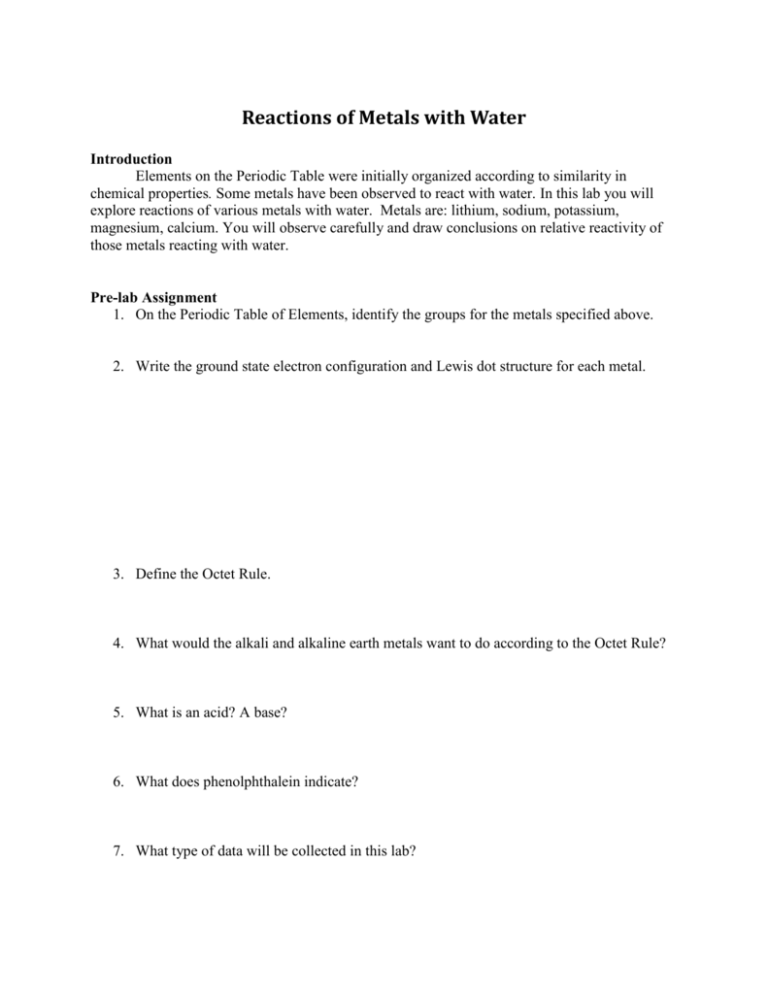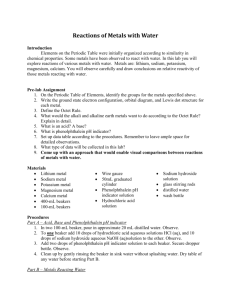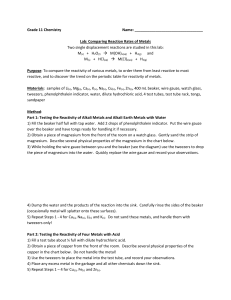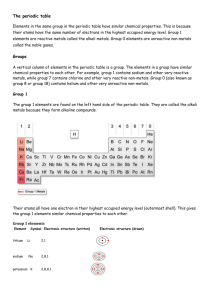Reactions of Metals with Water
advertisement

Reactions of Metals with Water Introduction Elements on the Periodic Table were initially organized according to similarity in chemical properties. Some metals have been observed to react with water. In this lab you will explore reactions of various metals with water. Metals are: lithium, sodium, potassium, magnesium, calcium. You will observe carefully and draw conclusions on relative reactivity of those metals reacting with water. Pre-lab Assignment 1. On the Periodic Table of Elements, identify the groups for the metals specified above. 2. Write the ground state electron configuration and Lewis dot structure for each metal. 3. Define the Octet Rule. 4. What would the alkali and alkaline earth metals want to do according to the Octet Rule? 5. What is an acid? A base? 6. What does phenolphthalein indicate? 7. What type of data will be collected in this lab? Materials Lithium metal Sodium metal Potassium metal Magnesium metal Calcium metal 400-mL beakers 100-mL beakers Wire gauze 50mL graduated cylinder Phenolphthalein pH indicator solution Hydrochloric acid solution Sodium hydroxide solution glass stirring rods distilled water wash bottle Procedures Part A – Acid, Base and Phenolphthalein pH indicator 1. In two 100-mL beakers, pour in approximately 20 mL distilled water. Observe. 2. Add 10 drops of hydrochloric acid aqueous solution to one beaker, and 10 drops of sodium hydroxide aqueous solution to the other. Observe. 3. Introduce two drops of phenolphthalein pH indicator solution to each beaker. Observe. 4. Clean up according to instructions from the teacher. Part B – Metals Reacting Water 1. In a 400-mL beaker, pour in approximate 200 mL distilled water. 2. Obtain a small piece of metal from the teacher on a piece of Parafilm. Observe. 3. Drop the metal into the 400-mL beaker with distilled water. Put the wire gauze immediately over the beaker to prevent splashing. Observe. 4. Allow the reaction (if there is any) to proceed to its completion. Observe. 5. Introduce a couple of drops of phenolphthalein pH indicator solution into the reaction mixture. Observe. 6. Repeat step 1-5 for each metal. Note: lithium, sodium and potassium have to be obtained from the teacher. Magnesium and calcium are in the sample vials. 7. Clean up according to instructions from the teacher. Data: (Write all observations in the Data Tables below.) Part A – Acid, Base and Phenolphthalein pH indicator\ Hydrochloric Acid with Phenolphthalein Sodium Hydroxide with Phenolphthalein Part B – Metals Reacting Water Metal Before Dropped in Water Immediately After Dropped in Water Reaction After pH indicator Lithium Sodium Potassium Magnesium Calcium Data Analysis: Part A – Acid, Base and Phenolphthalein pH indicator Any observed color change in solutions? Part B – Metals Reacting Water Any observable differences in reactivity of metals with water? Any observable trends? Post-lab Questions: 1. Is there any difference in terms of reactivity towards water from different metals? 2. If yes, any trends? 3. Explain any observed difference in relative reactivity towards water? Be specific. 4. Based on your understanding of the Periodic Table of elements and Octet Rule, predict the trend of reactivity for the halogen family of elements.









